The Variability of Mercury Content in Bituminous Coal Seams in the Coal Basins in Poland
Abstract
1. Introduction
2. Mercury Content in the Polish Coals
3. Materials and Methods
- -
- Seam “A” in two locations separated by a 10-m distance, in the bottom part where clarain coal occurs and in barren partings of claystone, coal laminated;
- -
- Seam “B” in two locations separated by a 22-m distance, in the bottom, middle and upper part formed by vitrain and clarain coal, respectively;
- -
- Seam “C” in the central part built of vitrain coal and in the bottom part of vitrain coal with iron sulfide in the cleats.
4. Results
5. Discussion
6. Conclusions
Author Contributions
Funding
Conflicts of Interest
References
- Zhao, S.; Pudasainee, D.; Duan, Y.-F.; Gupta, R.; Liu, M.; Lu, J. A review on mercury in coal combustion process: Content and occurrence forms in coal, transformation, sampling methods, emission and control technologies. Prog. Energy Combust. Sci. 2019, 73, 26–64. [Google Scholar] [CrossRef]
- Kolker, A.; Senior, C.L.; Quick, J.C. Mercury in coal and the impact of coal quality on mercury emissions from combustion systems. Appl. Geochem. 2006, 21, 1821–1836. [Google Scholar] [CrossRef]
- Yudovich, Y.E.; Ketris, M.P. Rtut’ w uglach—Serieznaya ekologicheskaya problema. Biosfera 2009, 1, 237–247. [Google Scholar]
- Michalska, A.; Białecka, B. Zawartość rtęci w węglu i odpadach górniczych. Pr. Nauk. GIG Górnictwo Środowisko 2012, 3, 73–87. [Google Scholar]
- Meij, R.; Winkel, B.H. Trace elements in world steam coal and their behavior in Dutch coal-fired power stations—A review. Int. J. Coal Geol. 2009, 77, 289–293. [Google Scholar] [CrossRef]
- Olkuski, T. Porównanie zawartości rtęci w węglach polskich i amerykańskich. Polityka Energetyczna 2007, 10, 603–611. [Google Scholar]
- Bojakowska, I.; Sokołowska, G. Rtęć w kopalinach wydobywanych w Polsce jako potencjalne źródło zanieczyszczeń środowiska. Biuletyn PIG 2001, 394, 5–54. [Google Scholar]
- Smoliński, A. Energetyczne wykorzystanie węgla źródłem emisji rtęci—Porównanie zawartości tego pierwiastka w węglach. Ochr. Powietrza Probl. Odpadów 2007, 41, 45–53. [Google Scholar]
- Pajdak, A.; Łuczkowska, D.; Walawska, B. Assessment of the possibilities of passive mercury removal in dry flue gas cleaning with sodium reagents. ZZesz. Nauk. Inst. Gospod. Surowcami Miner. Energią PAN 2017, 97, 95–106. [Google Scholar]
- Bojakowska, I.; Szczęśniak, H. Zagrożenie naturalnego środowiska w Polsce rtęcią w wyniku spalania węgli. Przegląd Geol. 1993, 4, 252–257. [Google Scholar]
- Goodarzi, F. Assessment of elemental content of milled coal, combustion residues, and stack emitted materials: Possible environmental effects for a Canadian pulverized coal-fired power plant. Int. J. Coal Geol. 2006, 65, 17–25. [Google Scholar] [CrossRef]
- Mastalerz, M.; Drobniak, A.; Filippelli, G. Mercury Content of Indiana Coals. In Research of Indiana Geological Survey; Indiana University: Bloomington, IN, USA, 2006. [Google Scholar]
- Aleksa, H.; Dyduch, F.; Wiechowski, K. Chlor i rtęć w węglu i możliwości ich obniżenia metodami przeróbki mechanicznej. Górnictwo Geoinżynieria 2007, 31, 35–48. [Google Scholar]
- Kolker, A.; Belkin, H.E. Characteristics of mercury-rich and extreme mercury-rich coals in the Donbas Region of Ukraine and Guizhou Province China. In Proceedings of the International Conference on Coal Science and Technology, Nottingham, UK, 28–31 August 2007. [Google Scholar]
- Bukowski, Z.; Burczyk, A. Oznaczanie Rtęci w Węglach Koksujących. Analiza Korelacji; Konferencja Koksownictwo: Zakopane, Poland, 2008. [Google Scholar]
- Wichliński, M.; Kobyłecki, R.; Bis, Z. The Investigation of Mercury Contents in Polish Coal Samples. Arch. Environ. Prot. 2013, 39, 141–150. [Google Scholar] [CrossRef]
- Białecka, B.; Pyka, I. Rtęć w Polskim Węglu Kamiennym do Celów Energetycznych i w Produktach Jego Przeróbki, 1; Główny Instytut Górnictwa Katowice: Katowice, Poland, 2016; pp. 1–167. [Google Scholar]
- Baic, I.; Blaschke, W. Badania wstępne nad ograniczeniem zawartości rtęci w energetycznym węglu kamiennym poprzez zastosowanie wibracyjnego powietrznego stołu koncentracyjnego. Rocz. Ochr. Środowiska—Ann. Ual Set Environ. Prot. 2017, 19, 480–496. [Google Scholar]
- Yudovich, Y.E.; Ketris, M.P. Mercury in coal: A review—Part 1. Geochemistry. Int. J. Coal Geol. 2005, 62, 107–134. [Google Scholar] [CrossRef]
- Mastalerz, M.; Drobniak, A. Vertical variations of mercury in Pennsylvanian coal beds from Indiana. Int. J. Coal Geol. 2005, 63, 36–57. [Google Scholar] [CrossRef]
- Klojzy-Karczmarczyk, B.; Mazurek, J. Studies of mercury content in selected coal seams of the Upper Silesian Coal Basin. Gospod. Surowcami Miner. Miner. Resour. Manag. 2013, 29, 95–106. [Google Scholar] [CrossRef][Green Version]
- Wierzchowski, K.; Chećko, J.; Pyka, I. Variability of Mercury Content in Coal Matter from Coal Seams of The Upper Silesia Coal Basin. Arch. Min. Sci. 2017, 62, 843–856. [Google Scholar] [CrossRef]
- Strugała, A.; Makowska, D.; Bytnar, K.; Rozwadowska, T. Analysis of the contents of selected critical elements in waste from the hard coal cleaning process. Bull. Miner. Energy Econ. Res. Inst. Pol. Acad. Sci. 2014, 17, 77–88. [Google Scholar]
- Ketris, M.; Yudovich, Y. Estimations of Clarkes for Carbonaceous biolithes: World averages for trace element contents in black shales and coals. Int. J. Coal Geol. 2009, 78, 135–148. [Google Scholar] [CrossRef]
- Plewa, M. Igneous Rocks and Signs of Mineralization in the Western and Middle Part of the Wałbrzych Basin. In Prace Mineralogiczne PAN, 12; Wydawnictwo Geologiczne: Warsaw, Poland, 1968; pp. 1–64. [Google Scholar]
- Morawiecki, A. Dickite and kaolinite veins (pholerites) from Nowa Ruda in Lower Silesia. Biul. Inst. Geol. 1956, 103, 5–38. [Google Scholar]
- Kolker, A.; Panov, B.S.; Panov, Y.B.; Landa, E.R.; Conko, K.M.; Korchemagin, V.A.; Shendrik, T.; Mccord, J.D. Mercury and trace element contents of Donbas coals and associated mine water in the vicinity of Donetsk, Ukraine. Int. J. Coal Geol. 2009, 79, 83–91. [Google Scholar] [CrossRef]
- Stryszewski, M. Eksploatacja Selektywna Węgla Brunatnego Jako Metoda Ograniczenia Szkodliwego Oddziaływania na Środowisko Pierwiastków Obecnych w Węglu i Produktach Jego Spalania (Na Przykładzie KWB Bełchatów), 1; AGH: Crakow, Poland, 2001; pp. 1–144. [Google Scholar]
- Słupczyński, K. The problem of genesis of natural gases collected in the Lower Permian formations. Zesz. Nauk. Politech. Śląskiej no. 865 (Górnictwo) 1987, 40, 39–48. [Google Scholar]
- Озерова, Н.А. Ртуть и Эндогенное Рудообразование, 1; Наука: Moscow, Russia, 1986; pp. 86–103. [Google Scholar]
- Finkelman, R.B. Modes of occurrence of trace elements in coal. Open-File Rep. 1981. [Google Scholar] [CrossRef]
- O’Neil, B.T.; Tewalt, S.J.; Finkelman, R.B.; Akers, D.J. Mercury concentration in coal—Unraveling the puzzle. Fuel 1999, 78, 47–54. [Google Scholar]
- Hower, J.C.; Campbell, J.L.; Teesdale, W.J.; Nejedly, Z.; Robertson, J.D. Scanning proton microprobe analysus of mercury and other trace element in Fe-sulfides from a Kentucky coal. Int. J. Coal Geol. 2008, 75, 88–92. [Google Scholar] [CrossRef]
- Dziok, T.; Strugała, A.; Włodek, A. Studies on mercury occurrence in inorganic constituents of Polkish coking coals. Environ. Sci. Pollut. Res. 2019, 26, 8371–8382. [Google Scholar] [CrossRef] [PubMed]
- Dziok, T.; Strugała, A.; Rozwadowski, A.; Macherzyński, M.; Ziomber, S. Rtęć w odpadach z procesów w zbogacania węgli kamiennych. Gospod. Surowcami Miner. Miner. Resour. Manag. 2015, 31, 107–122. [Google Scholar] [CrossRef]
- Ruppert, L.F.; Hower, J.C.; Eble, C.F. Arsenic-bearing pyrite and marcasite ibn the Fire Clay coal bed, Middle Pennsylvanian Breathitt Formarion, eastern Kentucky. Int. J. Coal Geol. 2005, 63, 27–35. [Google Scholar] [CrossRef]
- Nieć, M.; Kurek, S.; Preidl, M. Zagadnienie dokumentowania zawartości pierwiastków śladowych w złożach węgli. Metod. Rozpoznawania Dok. Złóż Kopali Stałych 1990, 2, 185–190. [Google Scholar]
- Finkelman, R.B. Mercury in coal and mercury emissions from coal combustion. In Geological Studies of Mercury by the U.S. Geological Survey; U.S. Geological Survey Circular: Denver, CO, USA, 2003; Volume 1248, pp. 9–11. [Google Scholar]
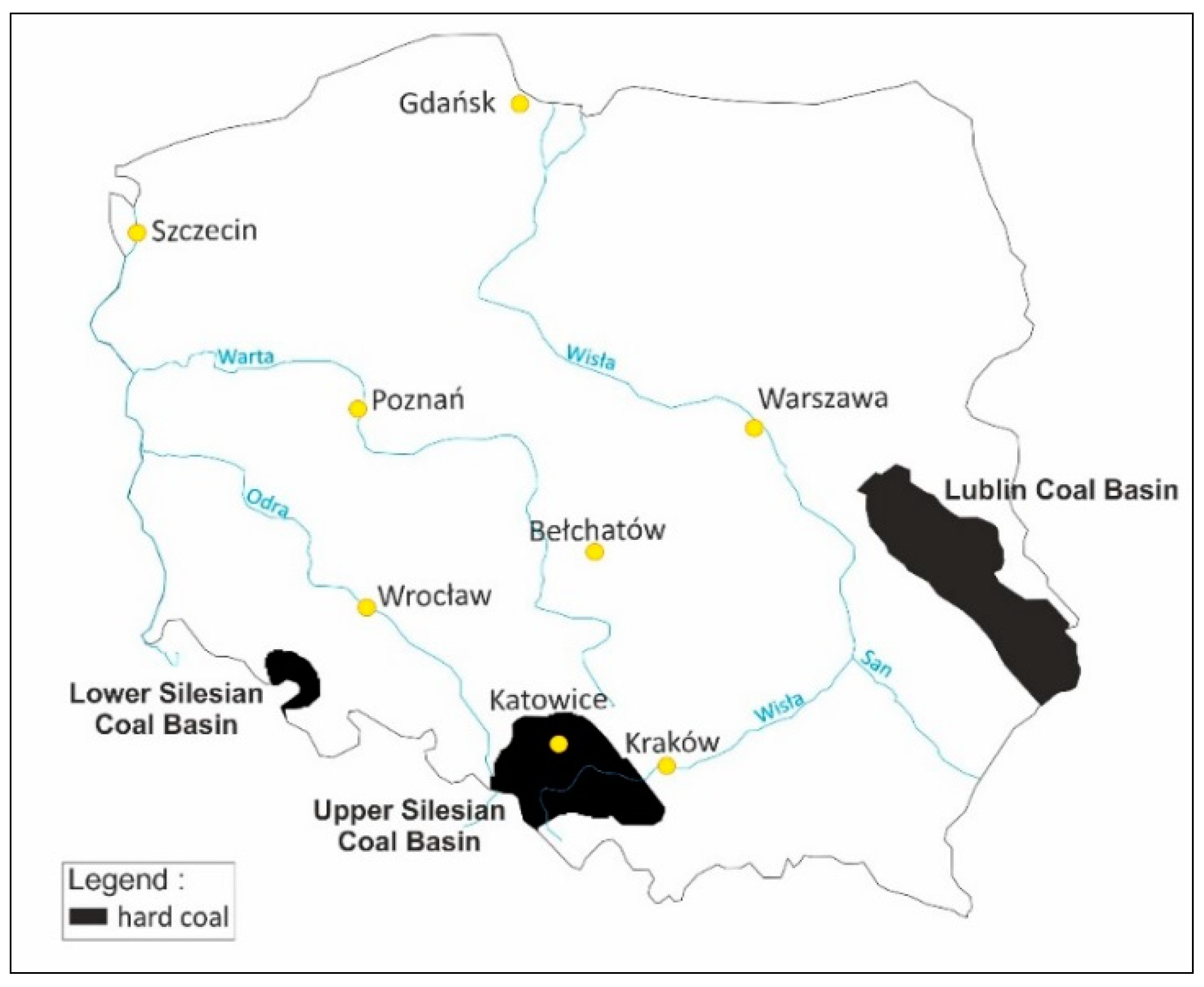
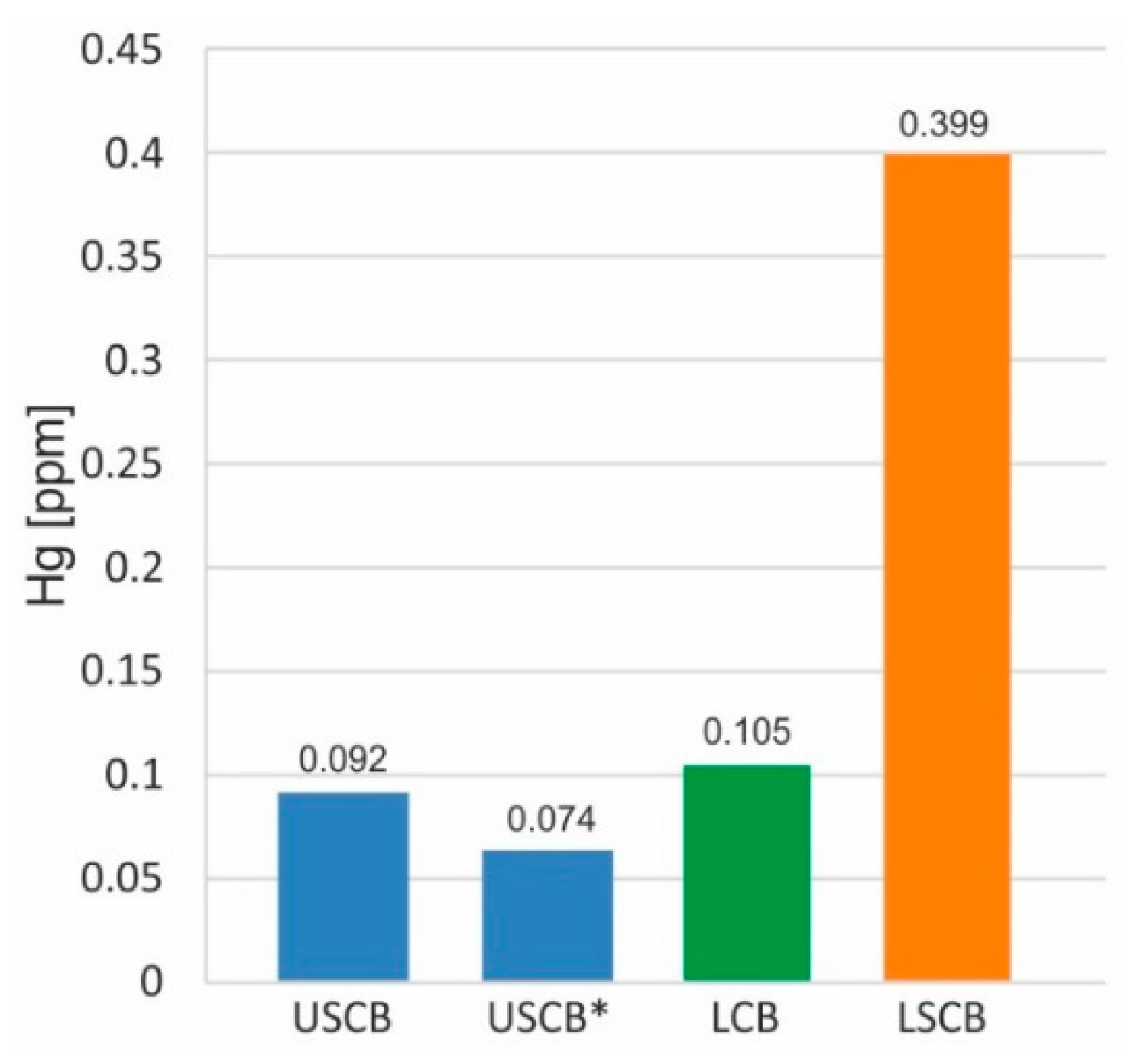
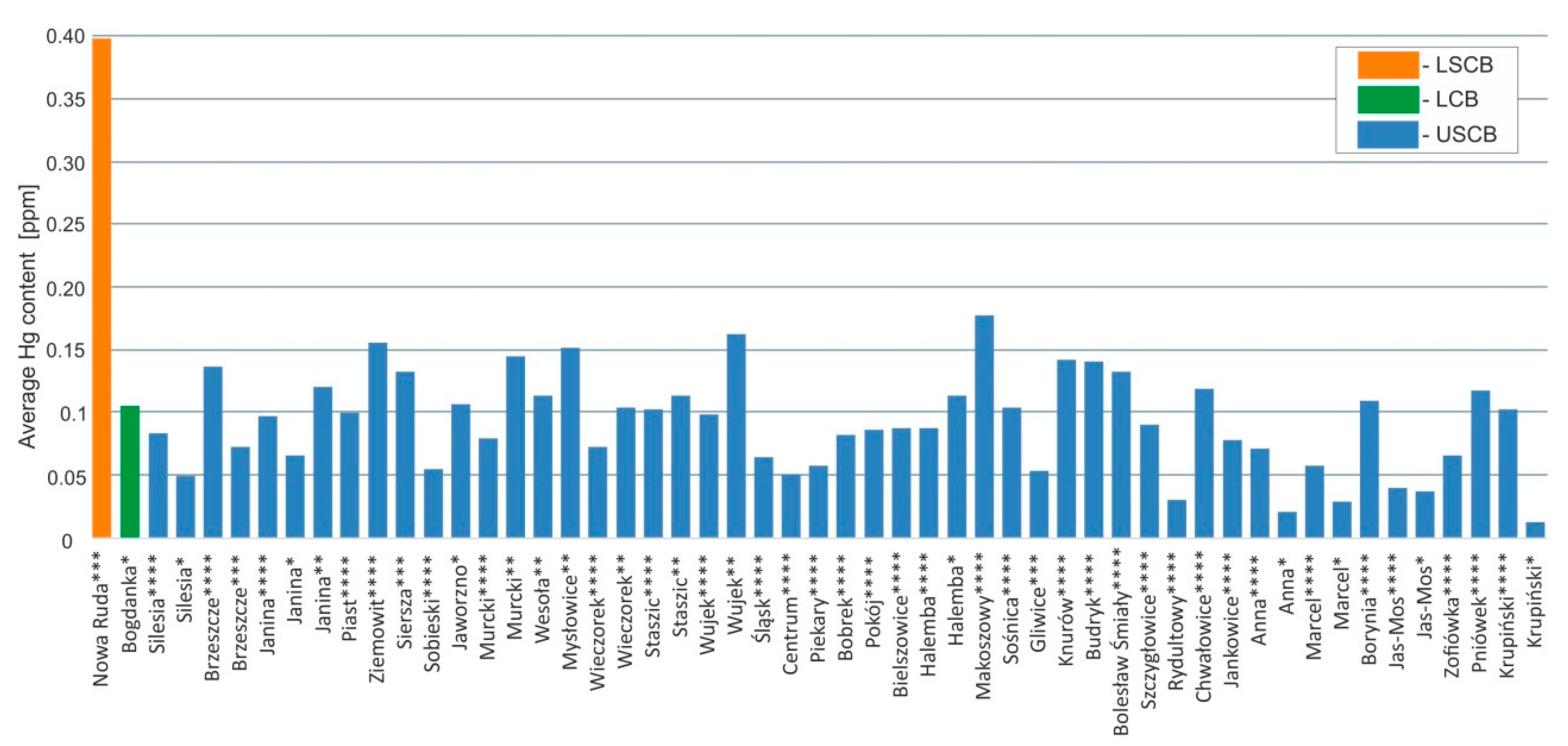
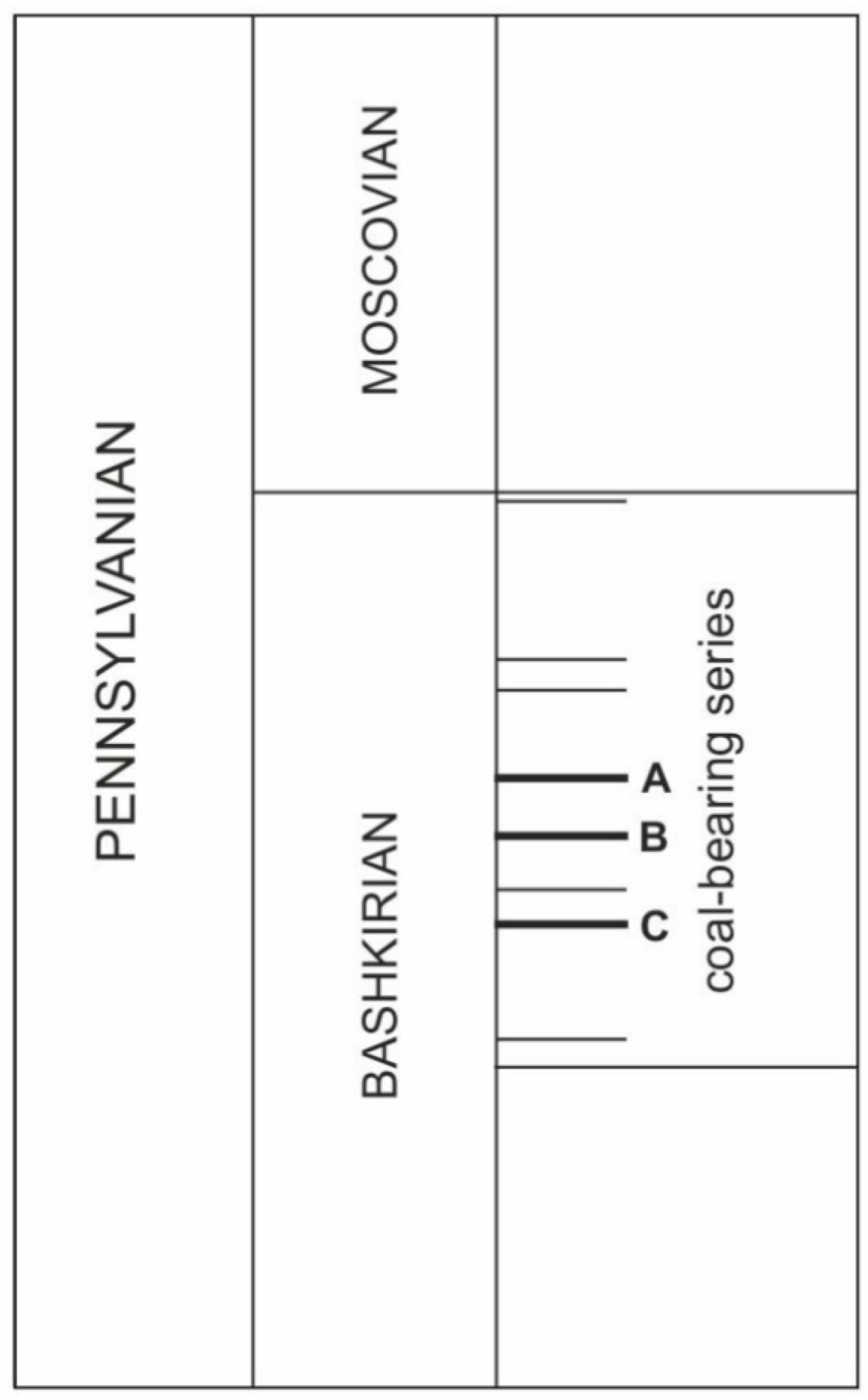
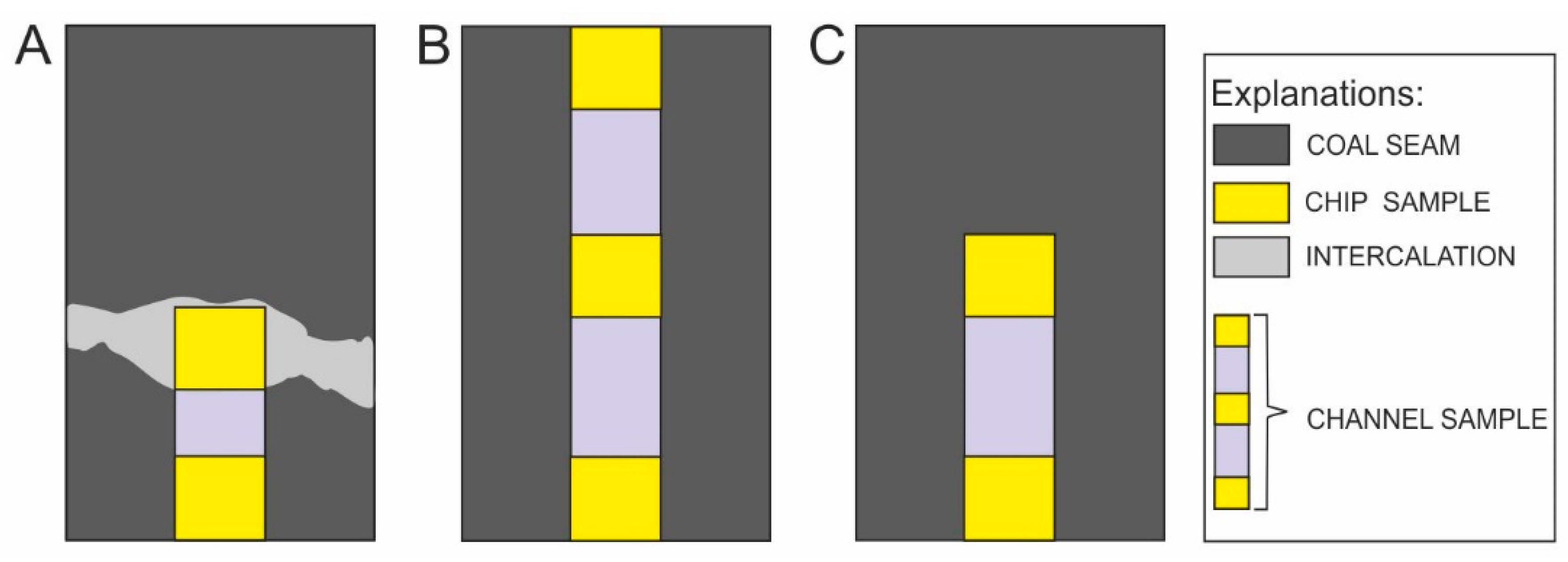
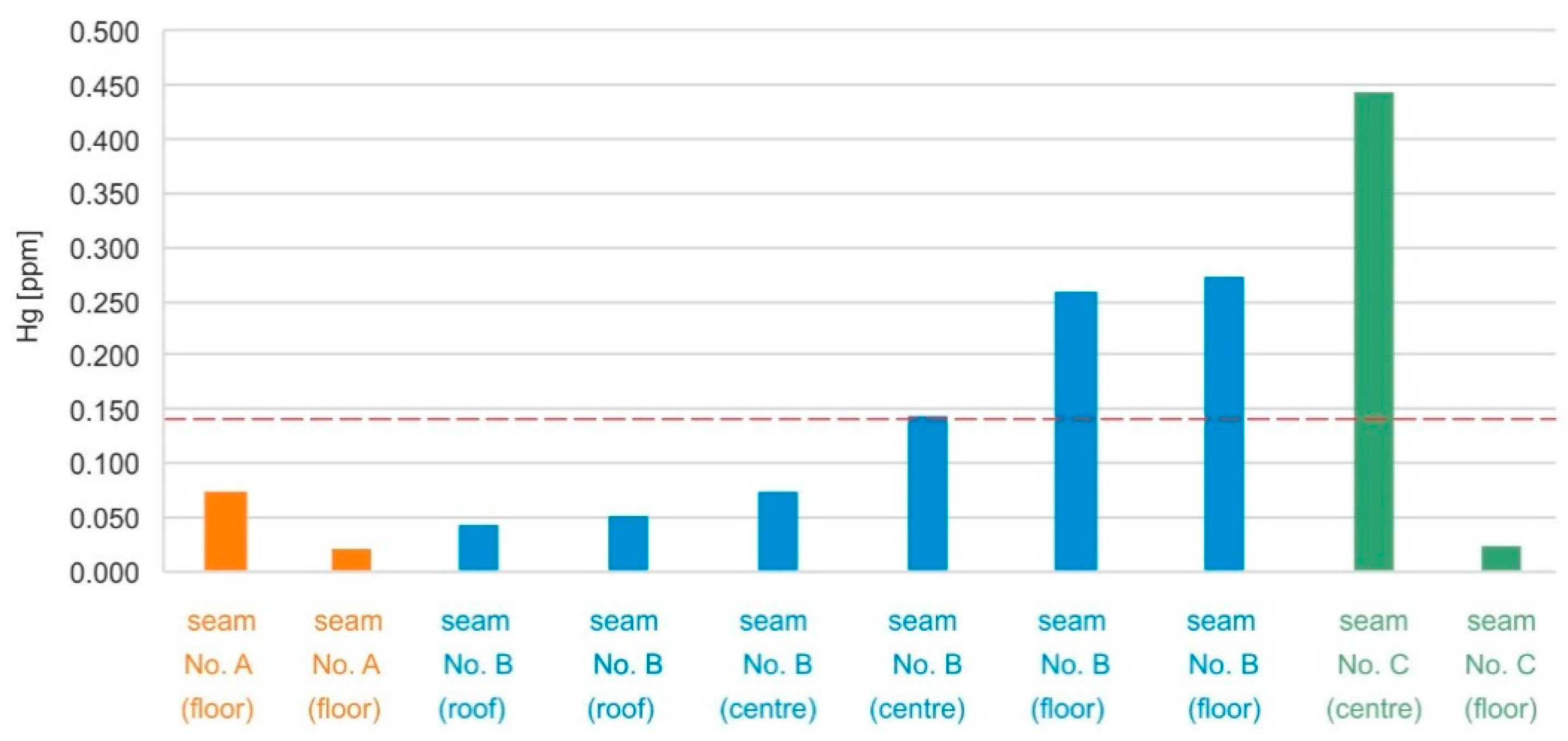
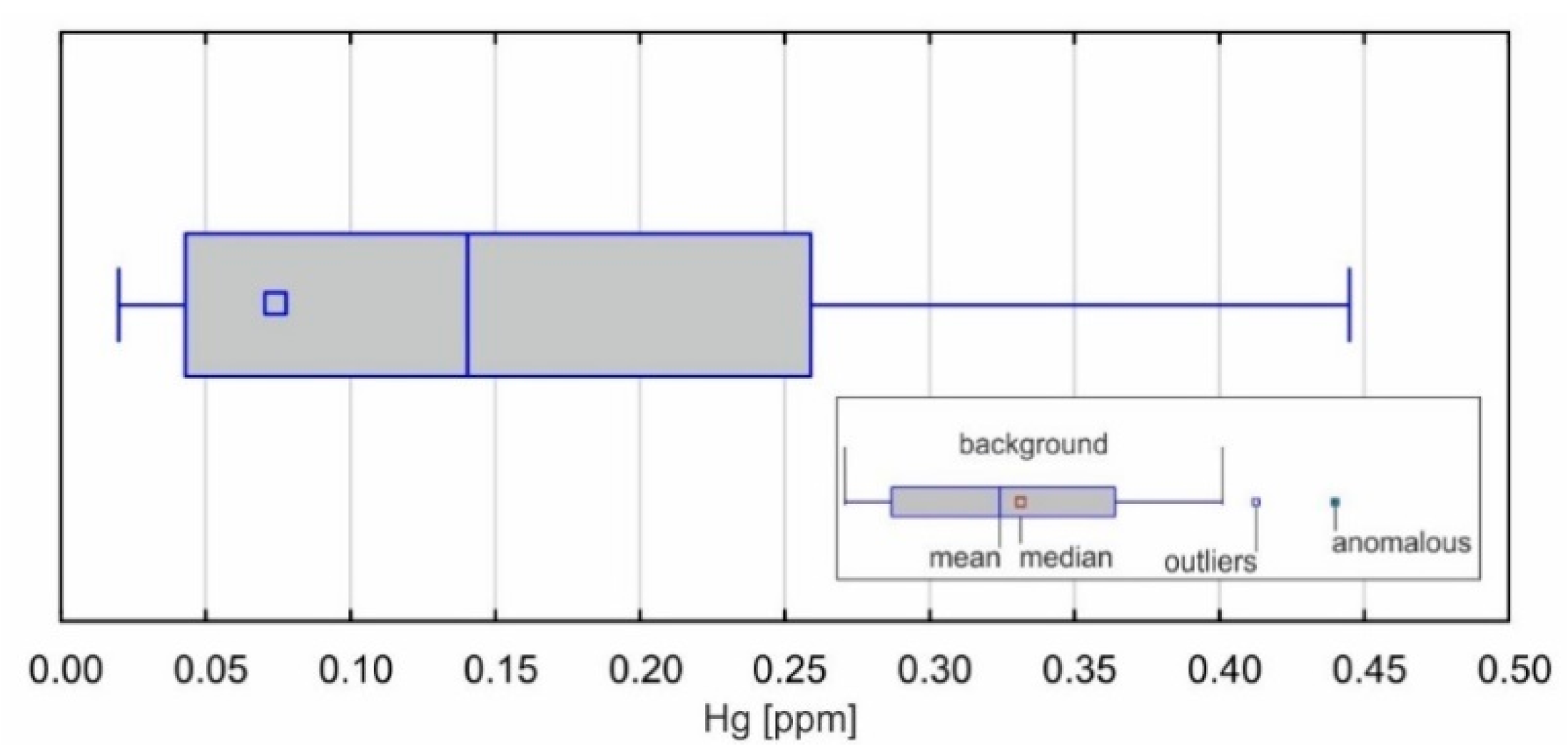
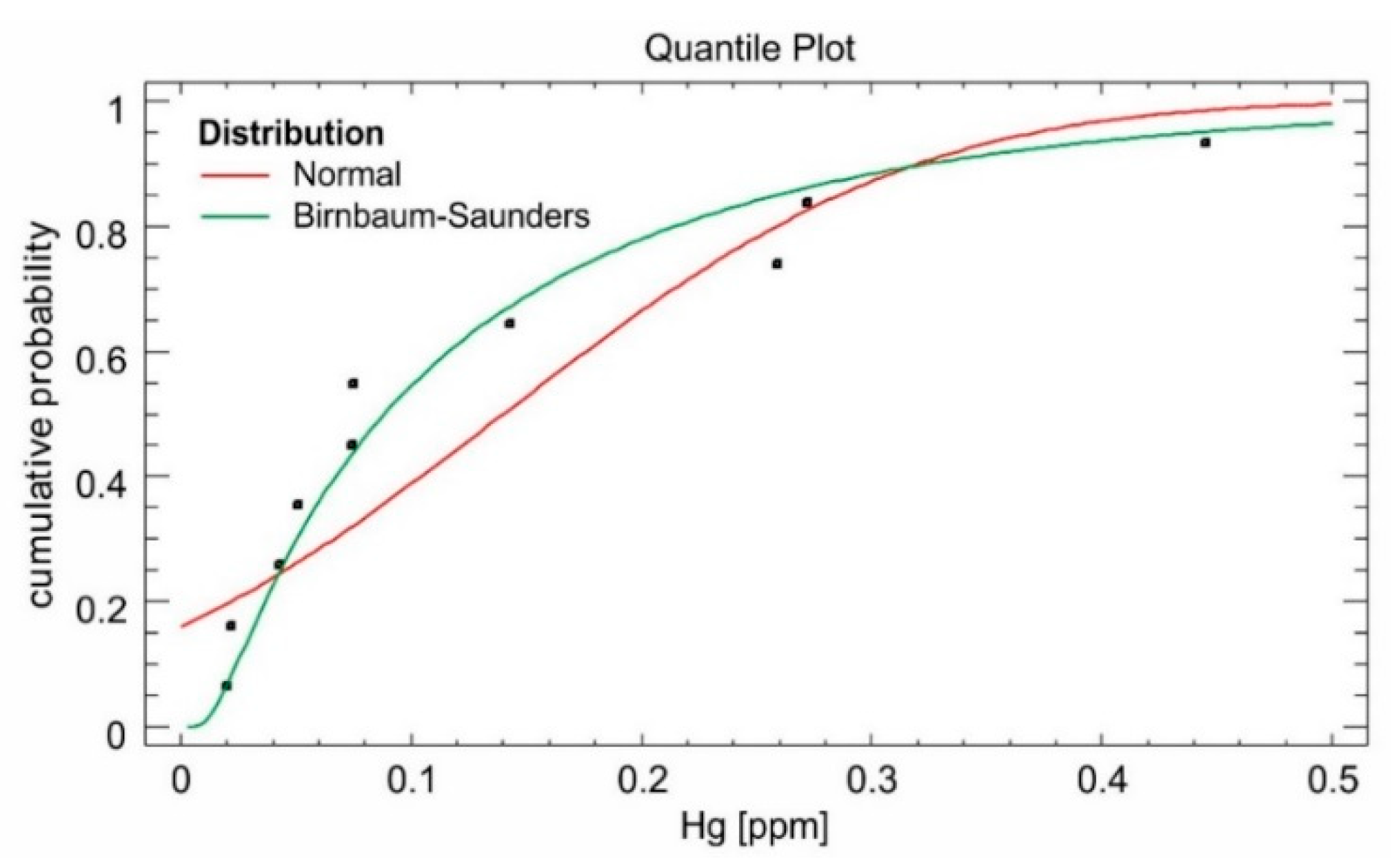
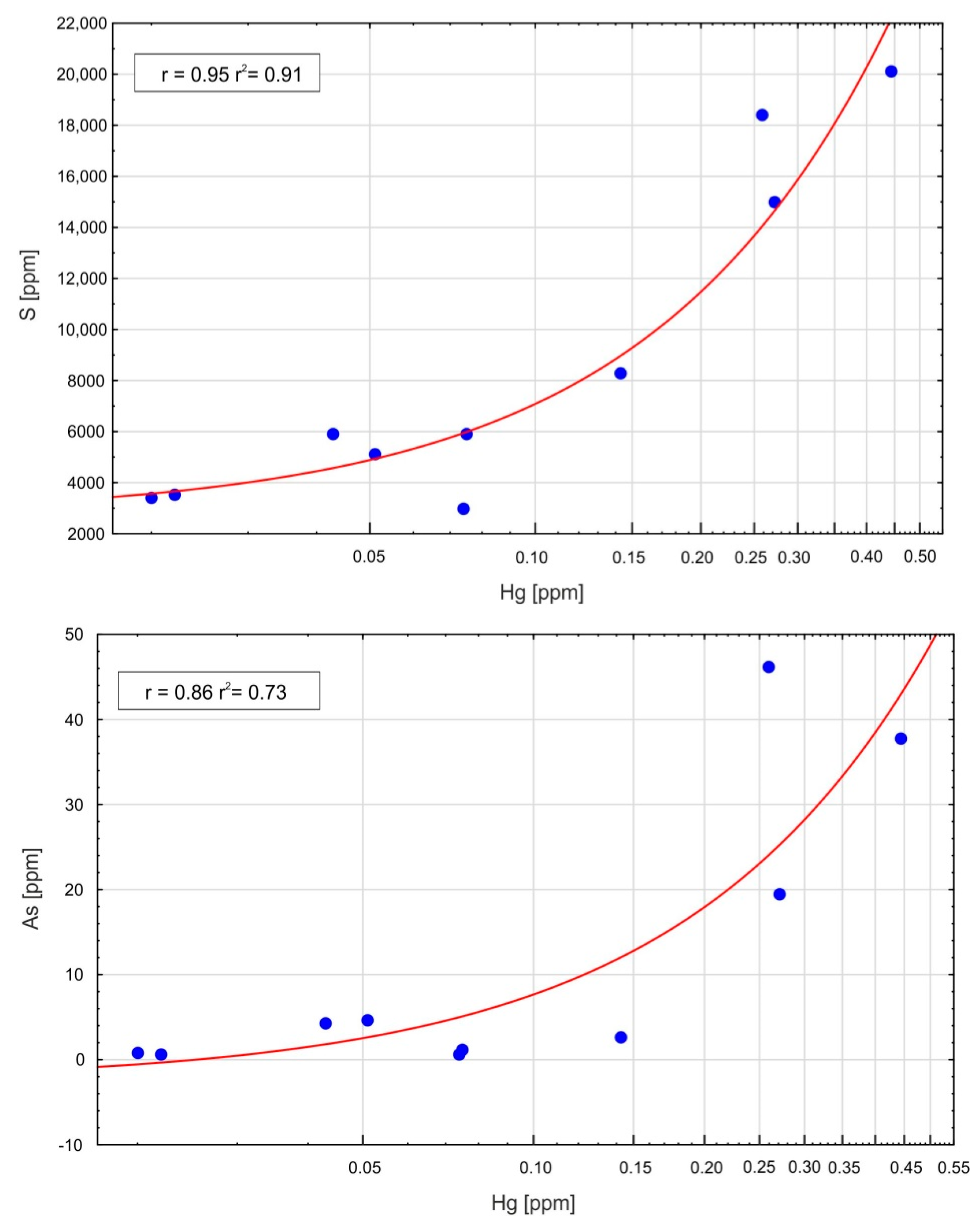
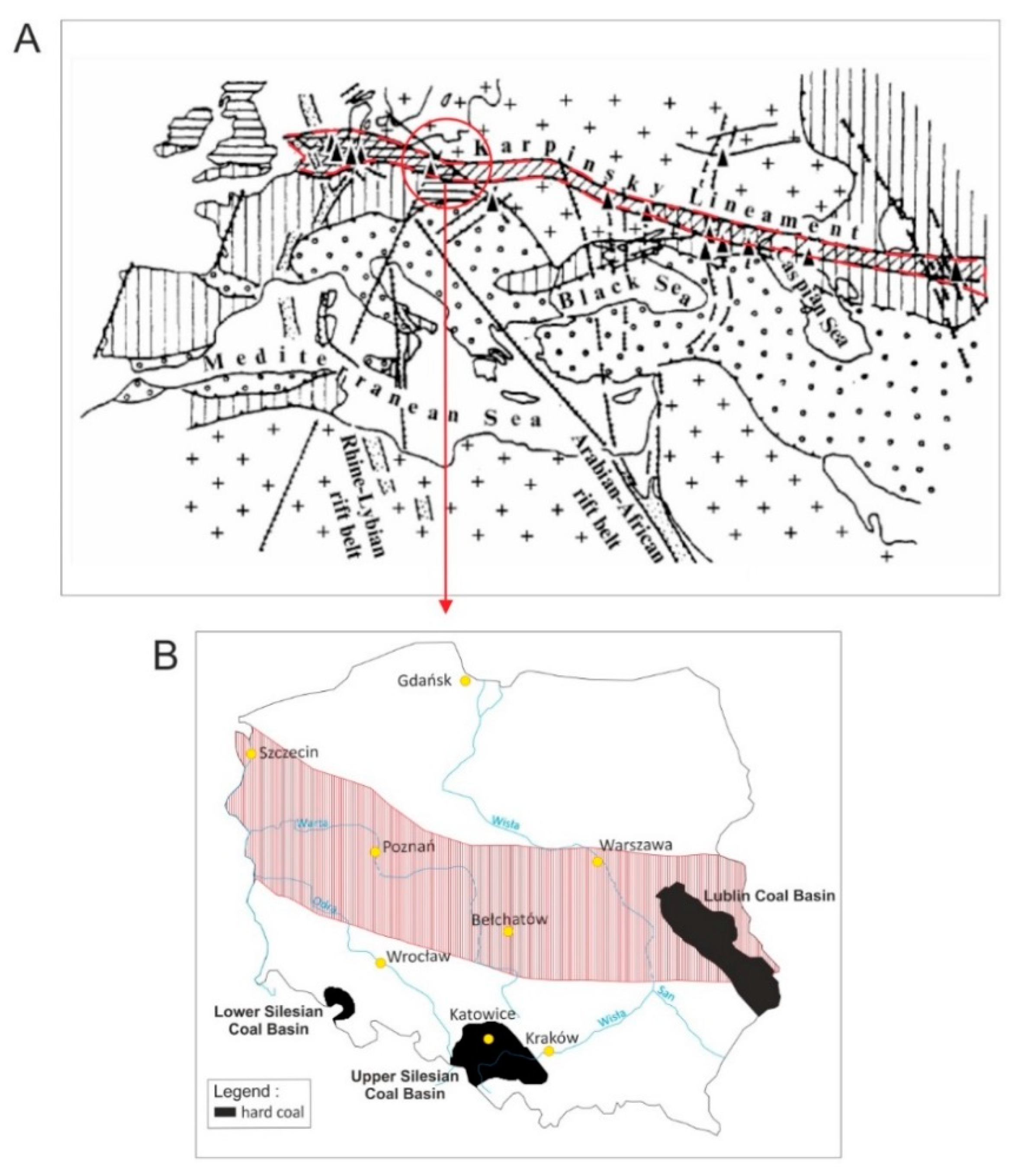
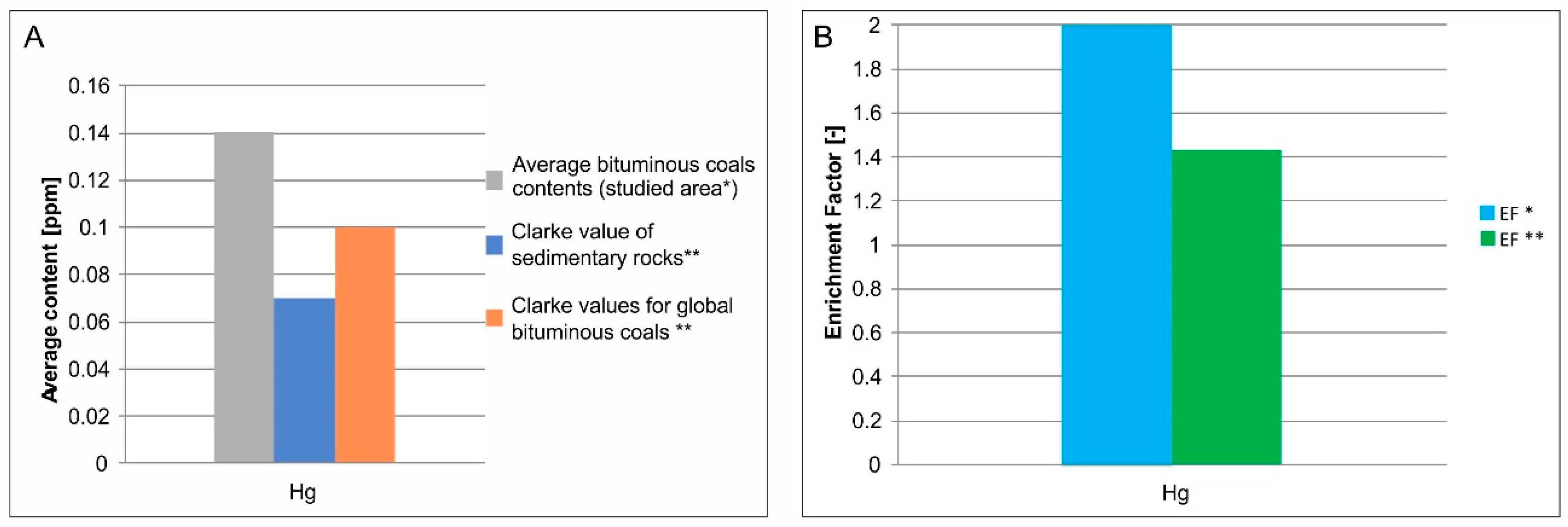
| Coal Seam and Sample Location | ||||||||||
|---|---|---|---|---|---|---|---|---|---|---|
| Element | A Bottom Part | A Bottom Part | B Upper Part | B Upper Part | B Bottom Part | B Upper Part | B Central Part | B Bottom Part | C Central Part | C Bottom Part |
| Hg (ppm) | 0.074 | 0.02 | 0.043 | 0.143 | 0.259 | 0.051 | 0.075 | 0.272 | 0.445 | 0.022 |
| S (ppm) | 3000 | 3400 | 5900 | 8300 | 18,400 | 5100 | 5900 | 15,000 | 20,100 | 3500 |
| As (ppm) | 0.7 | 0.9 | 4.2 | 2.6 | 46.1 | 4.7 | 1.2 | 19.4 | 37.7 | 0.7 |
| Element | Number | Average | Median | Standard Deviation | Variation Coefficient | Min. | Max. | |||
| Hg (ppm) | 10 | 0.140 | 0.075 | 0.141 | 100.4% | 0.020 | 0.445 | |||
| S (ppm) | 10 | 0.886 | 0.590 | 0.650 | 73.3% | 0.300 | 2.010 | |||
| As (ppm) | 10 | 11.82 | 3.40 | 16.912 | 142.1% | 0.70 | 46.10 | |||
| Sample | Sample 1 | Sample 2 |
|---|---|---|
| Hg (ppm) | 0.649 | 0.045 |
| S (%) | 2.20 | 0.12 |
| As (ppm) | 10.50 | 1.20 |
Publisher’s Note: MDPI stays neutral with regard to jurisdictional claims in published maps and institutional affiliations. |
© 2020 by the authors. Licensee MDPI, Basel, Switzerland. This article is an open access article distributed under the terms and conditions of the Creative Commons Attribution (CC BY) license (http://creativecommons.org/licenses/by/4.0/).
Share and Cite
Auguścik-Górajek, J.; Nieć, M. The Variability of Mercury Content in Bituminous Coal Seams in the Coal Basins in Poland. Resources 2020, 9, 127. https://doi.org/10.3390/resources9110127
Auguścik-Górajek J, Nieć M. The Variability of Mercury Content in Bituminous Coal Seams in the Coal Basins in Poland. Resources. 2020; 9(11):127. https://doi.org/10.3390/resources9110127
Chicago/Turabian StyleAuguścik-Górajek, Justyna, and Marek Nieć. 2020. "The Variability of Mercury Content in Bituminous Coal Seams in the Coal Basins in Poland" Resources 9, no. 11: 127. https://doi.org/10.3390/resources9110127
APA StyleAuguścik-Górajek, J., & Nieć, M. (2020). The Variability of Mercury Content in Bituminous Coal Seams in the Coal Basins in Poland. Resources, 9(11), 127. https://doi.org/10.3390/resources9110127






